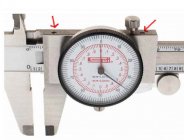For a 6 inch rack and pinion Dial caliper clean and adjust slide TENSION.
A gage pin measured at 2 points along the jaws verifies parallelism.
Once the initial rack length for outside measurement is verified with a gage block (4 inchs should be adequate) It is not likely to change unless damaged, dirty, or worn.
The rack can be verified at a few lengths with the appropriate blocks.
Note that thermal expansion of S.S. is about 6 microinches per inch and the rack was made to be accurate @ 68 degrees F.
For measurement @ 88F that would be 20F X 6 X 4 or or about a half thou for a 4 inch measurement. Readings would be LOW due to a longer rack.
Don't HOLD the caliper for long periods or body temperature might cause readings to change with time. Try it.
For measurements of an inch or less thermal effect is about a needle width.
For most dial calipers the rack pitch is 0.025" per tooth. The teeth of the rack, pinion and needle gear train are subject to dirt and wear.
Running a Dial Caliper in or out several inches FAST increases wear.
Remember that there is a delicate gear train in there.
Take one apart to see all the cute little parts

Idler gears are spring loaded to help reduce backlash caused by wear.
Try to feel/visualize thumb wheel movement to a slow smooth dial/needle movement, looking for jumps or erratic movement.
How does a dial caliper work? Shop for Dial Calipers Dial calipers use a rack and pinion mechanism system, which transfers the linear movement of the jaws of the caliper to the rotary motion of the dial indicator. Inside the dial there is a train of gears which mechanically drive the dial...

www.wonkeedonkeetools.co.uk
Operator FEEL can cause errors that are reduced with PRACTICE (experience) measuring KNOWN lengths, flat and round.
Feel is likely the major measurement error in caliper use, with wear coming up second. These are CRITICAL for repeatability.
Sometimes absolute accuracy isn't needed, like sorting parts.
Relative measurements can be used to find small or large dimensions.
Repeatability of the mechanism and the USER will determine how accurate YOUR measurements are.
A cheap pin gage set might be useful for PRACTICE.
Take a 0.061"-0250"set and dump them on a towel. Sort them back into the box with your Caliper. Check your work.














